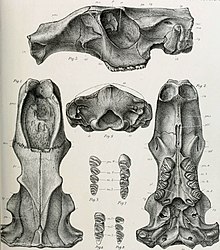| Trogontherium Temporal range: Late Pliocene–Late Pleistocene PreꞒ Ꞓ O S D C P T J K Pg N ↓ | |
|---|---|

| |
| Skull of Trogontherium cuvieri | |
| Scientific classification | |
| Domain: | Eukaryota |
| Kingdom: | Animalia |
| Phylum: | Chordata |
| Class: | Mammalia |
| Order: | Rodentia |
| Family: | Castoridae |
| Tribe: | †Trogontheriini |
| Genus: | †Trogontherium von Waldheim, 1809 |
| Type species | |
| †Trogontherium cuvieri von Waldheim, 1809 | |
| Other species | |
| |
Trogontherium is an extinct genus of Eurasian giant beavers that lived from the Late Pliocene to the Late Pleistocene. Fossils of Trogontherium have been found across northern Eurasia, from Western Europe to China and Siberia.
Taxonomy
Trogontherium was originally described in 1809 from a skull given to Gotthelf Fischer von Waldheim from the collection of Russian aristocrat Alexander Sergeyevich Stroganov found near Taganrog on the coast of the Sea of Azov in southern Russia, suggested to be Early Pleistocene in age. Originally, no species name was given. In 1824, Georges Cuvier cited the type species name as being T. cuvieri, attributing the species name to Waldheim, which has been followed by later authors. T. cuvieri is known from the Late Pliocene to Pleistocene of Eurasia. A distinctly smaller species, T. minus, named by Edwin Tulley Newton in 1890, is known from the Late Pliocene-earliest Pleistocene of Europe, where it co-existed with T. cuvieri. T. boisvilletti is generally considered a synonym of T. cuiveri. Some authors also include the species T. minutus from the Late Miocene of Europe, though this species has also been included in the genera Steneofiber or Euroxenomys, although it is clearly closely related to Trogontherium. Trogontherium has been placed as part of the subfamily Castoroidinae, which notably also includes North American giant beavers (Castoroides), though the large body size seems to have developed independently in both lineages.
Description
Trogontherium cuvieri grew larger than living beavers (Castor), with a skull up to 21 centimetres (8.3 in) in length, but was smaller than Castoroides. The incisors are covered in fine longitudinal grooves, and have a convex enamel face. The cheek teeth are high crowned. The sagittal suture of the skull is flanked by two deep depressions. The skull roof is largely flat, and the skull is overall much more robust and massive than that of modern beavers. Compared to Castor, the humerus and femur of T. cuiveri are proportionally shorter, but the radius, ulna, tibia and fibula bones are proportionally longer. The metatarsal bones and phalanges of the hindlimb were longer, more slender and narrower than in Castor, suggesting that the feet did not have well-developed webbing. The ankle joint had a limited calcaneo-fibular connection, unknown in any other rodent, but comparable to those in lagomorphs and ungulates, which served to stabilise the ankle joint.
Ecology
Trogontherium is thought to have engaged in gnawing like modern beavers, though its convex incisors would have made it less effective at gnawing through hard vegetation than the flattened incisors of living Castor, and would have functioned more like a gouge than a chisel. It may have fed by gnawing on bark and lignified roots. Dental microwear analysis of teeth of T. cuvieri from China, spanning the Pleistocene, suggest that it was ecologically plastic, and able to adapt its diet to local conditions. T. cuvieri is suggested to have occupied a different, more terrestrial niche than living Castor, as suggested by its more cursorially (running) adapted limbs, though it appears to have been closely associated with aquatic environments. At the Bilzingsleben site in Germany, dating to around 400–300,000 years ago, T. cuvieri is suggested to have been hunted by archaic humans, though it is much rarer at the site than remains of Castor.
Evolution and extinction
Trogontherium first appeared in Europe during the Pliocene, with the species T. cuvieri dispersing over to East Asia and Siberia at the Pliocene-Pleistocene boundary, around 2.6 million years ago. T. cuvieri became extinct in Europe in the late Middle Pleistocene, during the Saalian glaciation (~300-125,000 years ago). The last record of the species is from the Late Pleistocene of Manchuria near Harbin in Northeast China, around 40,000 years old. Its disappearance might be related to the arrival of hunter gatherers into the region.
References
- ^ Ł. Fostowicz-Frelik First record of Trogontherium cuvieri (Mammalia, Rodentia) from the middle Pleistocene of Poland and review of the species Geodiversitas, 30 (4) (2008), pp. 765-778
- ^ Korth, William W. (2001). "Comments on the Systematics and Classification of the Beavers (Rodentia, Castoridae)". Journal of Mammalian Evolution. 8 (4): 279–296. doi:10.1023/A:1014468732231. S2CID 27935955.
- ^ Yang, Yangheshan; Li, Qiang; Fostowicz-Frelik, Łucja; Ni, Xijun (April 2019). "Last record of Trogontherium cuvieri (Mammalia, Rodentia) from the late Pleistocene of China". Quaternary International. 513: 30–36. Bibcode:2019QuInt.513...30Y. doi:10.1016/j.quaint.2019.01.025. S2CID 135345352.
- ^ Yang, Yangheshan; Li, Qiang; Ni, Xijun; Cheng, Xiaodong; Zhang, Jie; Li, Honglong; Jin, Changzhu (July 2021). "Tooth micro-wear analysis reveals that persistence of beaver Trogontherium cuvieri (Rodentia, Mammalia) in Northeast China relied on its plastic ecological niche in Pleistocene". Quaternary International. 591: 70–79. Bibcode:2021QuInt.591...70Y. doi:10.1016/j.quaint.2021.01.004. S2CID 234255041.
- Heinrich, Wolf-Dieter; Maul, Lutz C. (2020). "Mortality profiles of Castor and Trogontherium (Mammalia: Rodentia, Castoridae), with notes on the site formation of the Mid-Pleistocene hominin locality Bilzingsleben II (Thuringia, Central Germany)". Fossil Imprint. 76 (1): 40–58. doi:10.37520/fi.2020.004. ISSN 2533-4069. S2CID 228681230.
| Taxon identifiers | |
|---|---|
| Trogontherium | |




